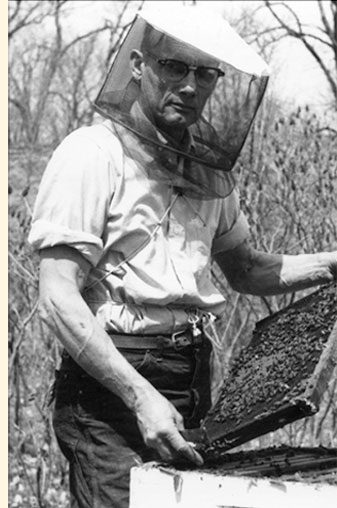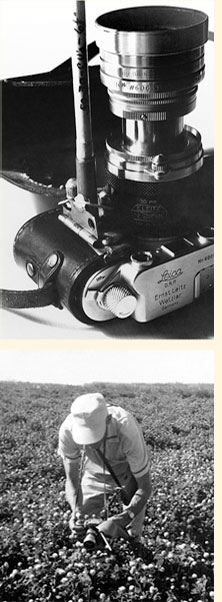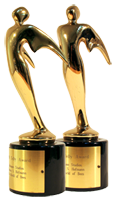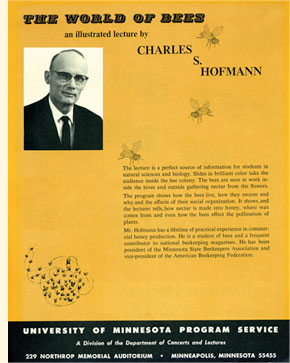|

 Many people knew Charles Hofmann by name in and around Janesville, Minnesota, where he was born and where he, and his father before him, operated Hofmann Apiaries. Many others in the area were aware only that there was a “honey farm” just north of Janesville in Waseca County, and for them he was known simply as “The Bee Man.” That title made him a de facto expert, and he was often asked to talk about bees before some group or other. Believing that simply talking about bees without some means of illustration would be inadequate, he began to think about how best to do it. In the end he decided that a slide lecture would be the most effective, and he set to work. Many people knew Charles Hofmann by name in and around Janesville, Minnesota, where he was born and where he, and his father before him, operated Hofmann Apiaries. Many others in the area were aware only that there was a “honey farm” just north of Janesville in Waseca County, and for them he was known simply as “The Bee Man.” That title made him a de facto expert, and he was often asked to talk about bees before some group or other. Believing that simply talking about bees without some means of illustration would be inadequate, he began to think about how best to do it. In the end he decided that a slide lecture would be the most effective, and he set to work.
Hofmann had long been interested in photography and in fact so interested that in 1952, despite modest means, he purchased a fine camera: a Leica IIIf. He immediately began to study photography in earnest. He read, took scores of pictures, made copious notes on the results, and learned from his mistakes. As it happened, in preparing for the slide lecture he intended to make he was on his way to becoming a fine photographer.
In creating his program he wanted to “ . . . show bees as other bees see them.” This meant utilizing macro-photography and all the associated problems involved in taking extreme close-up pictures of tiny moving objects under field conditions. Though already quite knowledgeable about photography he was initially dissatisfied with his results. He eventually devised and made special equipment, and developed methods that enabled him to finally obtain the images he wanted. Over the course of the next dozen or more years he compiled the slide lecture he called The World of Bees.
 Once finished he began presenting it to family and friends, and after some time and favorable results he decided to attempt the challenge of larger audiences. He eventually discovered that the University of Minnesota had an Off-Campus Department of Concerts and Lectures that contracted with people or groups to perform lyceum programs at schools. This seemed perfect, and he contacted the department. Though the director made clear that they hadn’t accepted a slide lecture in over ten years, Charles was none-the-less granted what he suspected was an audition out of courtesy. However, at the conclusion of his audition he was offered, on the spot, a position in the rotation of lyceum programs for the coming season. He accepted, and from 1967—1970 he completed two tours for fthe University. During that time he presented The World of Bees for an estimated 34,000 students. At the end of his second tour he was offered tours from two other regions but declined as the work was demanding, it kept him from home and important winter shop work, and perhaps more importantly, he had successfully met the challenge of seeing if his program might be recognized for the outstanding work it was. Over the following years Mr. Hofmann continued to present The World of Bees for many local and regional groups, and at a national convention of beekeepers. As he grew older and presentations became increasingly rare, his family began to wonder if there might be someway to preserve the work. At the suggestion of his eldest son, Larry, the decision was eventually made to produce Once finished he began presenting it to family and friends, and after some time and favorable results he decided to attempt the challenge of larger audiences. He eventually discovered that the University of Minnesota had an Off-Campus Department of Concerts and Lectures that contracted with people or groups to perform lyceum programs at schools. This seemed perfect, and he contacted the department. Though the director made clear that they hadn’t accepted a slide lecture in over ten years, Charles was none-the-less granted what he suspected was an audition out of courtesy. However, at the conclusion of his audition he was offered, on the spot, a position in the rotation of lyceum programs for the coming season. He accepted, and from 1967—1970 he completed two tours for fthe University. During that time he presented The World of Bees for an estimated 34,000 students. At the end of his second tour he was offered tours from two other regions but declined as the work was demanding, it kept him from home and important winter shop work, and perhaps more importantly, he had successfully met the challenge of seeing if his program might be recognized for the outstanding work it was. Over the following years Mr. Hofmann continued to present The World of Bees for many local and regional groups, and at a national convention of beekeepers. As he grew older and presentations became increasingly rare, his family began to wonder if there might be someway to preserve the work. At the suggestion of his eldest son, Larry, the decision was eventually made to produce  The World of Bees as a VHS program. Larry, an artist, also worked with computers, and it was he who took on the project. In close collaboration, father and son worked to make the changes necessary to adapt what had always been a live presentation into something for television. After months of intense effort the program was finally released in the spring of 1998 there-by ensuring that The World of Bees would live on after live presentations were no longer possible. The VHS received favorable reviews, was respected and sold well to its audience, and in 1999 won a bronze Telly Award, a long-running and respected competition for honoring film and video productions. The World of Bees as a VHS program. Larry, an artist, also worked with computers, and it was he who took on the project. In close collaboration, father and son worked to make the changes necessary to adapt what had always been a live presentation into something for television. After months of intense effort the program was finally released in the spring of 1998 there-by ensuring that The World of Bees would live on after live presentations were no longer possible. The VHS received favorable reviews, was respected and sold well to its audience, and in 1999 won a bronze Telly Award, a long-running and respected competition for honoring film and video productions.
 In 2007 Larry spoke with his father and broached the subject of re-issuing The World of Bees as a DVD. Technological advances in both hardware and software would allow great improvement over the original: it could be produced in widescreen format, it could be animated, and the fact that the VHS format was all but extinct were good reasons for considering the job. It was agreed that the project should go forward, but Charles passed away before work could get underway. The project was delayed until January 2012, when work fianlly began. Starting with the opening image, The World of Bees was then entirely re-built for DVD and Blu-ray. Every slide was re-scanned and restored or repaired as necessary as some images were nearly 60 years old. In 2014 The World of Bees received its second Telly Award. In 2007 Larry spoke with his father and broached the subject of re-issuing The World of Bees as a DVD. Technological advances in both hardware and software would allow great improvement over the original: it could be produced in widescreen format, it could be animated, and the fact that the VHS format was all but extinct were good reasons for considering the job. It was agreed that the project should go forward, but Charles passed away before work could get underway. The project was delayed until January 2012, when work fianlly began. Starting with the opening image, The World of Bees was then entirely re-built for DVD and Blu-ray. Every slide was re-scanned and restored or repaired as necessary as some images were nearly 60 years old. In 2014 The World of Bees received its second Telly Award.
Presented in widescreen with over 30 additional images, The World of Bees has been improved in nearly every way. Of course the qualities that made the VHS version a success are still intact: the extraordinary images, the wealth of information, the gentle humor, and the utter charm of the piece are all still there. But with the DVD and Blu-ray editions The World of Bees has become a polished and sparkling jewel; a program about honey bees that is completely unique and beautiful in ways that cannot quite be explained. One must see it from beginning to end to fully appreciate what an extraordinary work it is. At a time when honey bees are in peril many people have questions about them, and The World of Bees will not only answer most questions but provide those answers in a most entertaining and delightful way.
|
|


 Many people knew Charles Hofmann by name in and around Janesville, Minnesota, where he was born and where he, and his father before him, operated Hofmann Apiaries. Many others in the area were aware only that there was a “honey farm” just north of Janesville in Waseca County, and for them he was known simply as “The Bee Man.” That title made him a de facto expert, and he was often asked to talk about bees before some group or other. Believing that simply talking about bees without some means of illustration would be inadequate, he began to think about how best to do it. In the end he decided that a slide lecture would be the most effective, and he set to work.
Many people knew Charles Hofmann by name in and around Janesville, Minnesota, where he was born and where he, and his father before him, operated Hofmann Apiaries. Many others in the area were aware only that there was a “honey farm” just north of Janesville in Waseca County, and for them he was known simply as “The Bee Man.” That title made him a de facto expert, and he was often asked to talk about bees before some group or other. Believing that simply talking about bees without some means of illustration would be inadequate, he began to think about how best to do it. In the end he decided that a slide lecture would be the most effective, and he set to work.
 Once finished he began presenting it to family and friends, and after some time and favorable results he decided to attempt the challenge of larger audiences. He eventually discovered that the University of Minnesota had an Off-Campus Department of Concerts and Lectures that contracted with people or groups to perform lyceum programs at schools. This seemed perfect, and he contacted the department. Though the director made clear that they hadn’t accepted a slide lecture in over ten years, Charles was none-the-less granted what he suspected was an audition out of courtesy. However, at the conclusion of his audition he was offered, on the spot, a position in the rotation of lyceum programs for the coming season. He accepted, and from 1967—1970 he completed two tours for fthe University. During that time he presented The World of Bees for an estimated 34,000 students. At the end of his second tour he was offered tours from two other regions but declined as the work was demanding, it kept him from home and important winter shop work, and perhaps more importantly, he had successfully met the challenge of seeing if his program might be recognized for the outstanding work it was. Over the following years Mr. Hofmann continued to present The World of Bees for many local and regional groups, and at a national convention of beekeepers. As he grew older and presentations became increasingly rare, his family began to wonder if there might be someway to preserve the work. At the suggestion of his eldest son, Larry, the decision was eventually made to produce
Once finished he began presenting it to family and friends, and after some time and favorable results he decided to attempt the challenge of larger audiences. He eventually discovered that the University of Minnesota had an Off-Campus Department of Concerts and Lectures that contracted with people or groups to perform lyceum programs at schools. This seemed perfect, and he contacted the department. Though the director made clear that they hadn’t accepted a slide lecture in over ten years, Charles was none-the-less granted what he suspected was an audition out of courtesy. However, at the conclusion of his audition he was offered, on the spot, a position in the rotation of lyceum programs for the coming season. He accepted, and from 1967—1970 he completed two tours for fthe University. During that time he presented The World of Bees for an estimated 34,000 students. At the end of his second tour he was offered tours from two other regions but declined as the work was demanding, it kept him from home and important winter shop work, and perhaps more importantly, he had successfully met the challenge of seeing if his program might be recognized for the outstanding work it was. Over the following years Mr. Hofmann continued to present The World of Bees for many local and regional groups, and at a national convention of beekeepers. As he grew older and presentations became increasingly rare, his family began to wonder if there might be someway to preserve the work. At the suggestion of his eldest son, Larry, the decision was eventually made to produce  The World of Bees as a VHS program. Larry, an artist, also worked with computers, and it was he who took on the project. In close collaboration, father and son worked to make the changes necessary to adapt what had always been a live presentation into something for television. After months of intense effort the program was finally released in the spring of 1998 there-by ensuring that The World of Bees would live on after live presentations were no longer possible. The VHS received favorable reviews, was respected and sold well to its audience, and in 1999 won a bronze Telly Award, a long-running and respected competition for honoring film and video productions.
The World of Bees as a VHS program. Larry, an artist, also worked with computers, and it was he who took on the project. In close collaboration, father and son worked to make the changes necessary to adapt what had always been a live presentation into something for television. After months of intense effort the program was finally released in the spring of 1998 there-by ensuring that The World of Bees would live on after live presentations were no longer possible. The VHS received favorable reviews, was respected and sold well to its audience, and in 1999 won a bronze Telly Award, a long-running and respected competition for honoring film and video productions. In 2007 Larry spoke with his father and broached the subject of re-issuing The World of Bees as a DVD. Technological advances in both hardware and software would allow great improvement over the original: it could be produced in widescreen format, it could be animated, and the fact that the VHS format was all but extinct were good reasons for considering the job. It was agreed that the project should go forward, but Charles passed away before work could get underway. The project was delayed until January 2012, when work fianlly began. Starting with the opening image, The World of Bees was then entirely re-built for DVD and Blu-ray. Every slide was re-scanned and restored or repaired as necessary as some images were nearly 60 years old. In 2014 The World of Bees received its second Telly Award.
In 2007 Larry spoke with his father and broached the subject of re-issuing The World of Bees as a DVD. Technological advances in both hardware and software would allow great improvement over the original: it could be produced in widescreen format, it could be animated, and the fact that the VHS format was all but extinct were good reasons for considering the job. It was agreed that the project should go forward, but Charles passed away before work could get underway. The project was delayed until January 2012, when work fianlly began. Starting with the opening image, The World of Bees was then entirely re-built for DVD and Blu-ray. Every slide was re-scanned and restored or repaired as necessary as some images were nearly 60 years old. In 2014 The World of Bees received its second Telly Award.